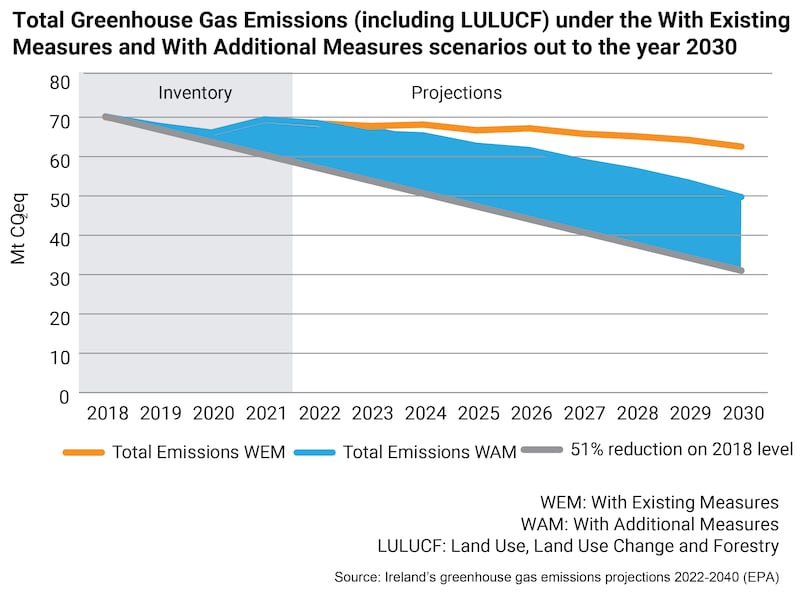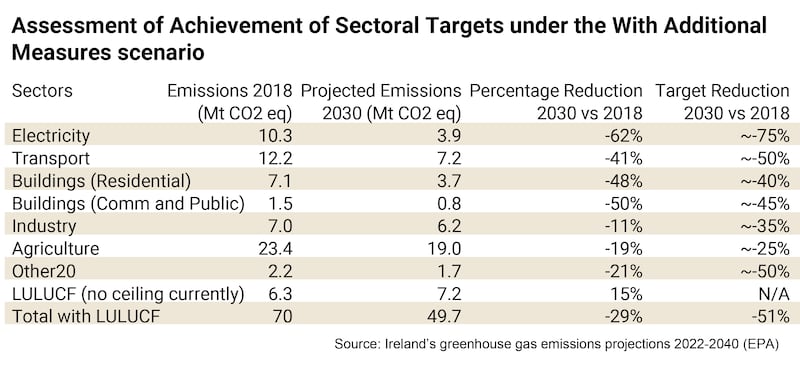Ireland will achieve a reduction of only 29 per cent in its greenhouse gas emissions by 2030, far short of a legally-binding target of 51 per cent that is core to the Government’s climate policy, according to the EPA’s latest projections.
Almost all sectors are on a trajectory to exceed their national ceilings – including agriculture, industry, electricity and transport.
The first two carbon budgets (2021-2025; 2026-2030) designed to impose limits on carbon arising from economic activity and households “will not be met, and by a significant margin”, it predicts in its starkest annual outline of projections out to 2040.
Reaching the 2030 target “now requires implementing policies that deliver emission reductions across all sectors of the economy in the short term”, it warns – including firming up existing plans, enhancing implementation and introducing a more ambitious 2024 climate plan to close large gaps.
How a hotter world is affecting Ireland in five graphics
The global fight for science in the face of Trump’s attacks
The ‘foot may be coming off the action pedal’: Climate plan fails to build on ambition
Measures in 2025 climate plan will be at centre of social and economic development, Government says

“Ireland needs to fully implement the actions in the 2023 climate action plan that have been defined; firm up the actions that currently don’t have associated policies and measures, such as diversification in agriculture; and identify and implement further policies and measures,” its analysis published on Friday finds.
These projections show strong economic activity, population growth and associated energy demand “are eroding the increased ambition in the 2023 climate action plan,” said EPA senior manager Stephen Treacy.
“This underlines the urgency of moving to an economy and society powered by renewable energy sources. The longer we wait, the longer it will be before we realise the benefits as the time horizon for achievement of national and EU commitments is getting ever shorter,” he added.
[ Ireland ‘turning ship around’ on climate despite targets shortfall, says RyanOpens in new window ]
Stop Climate Chaos coalition coordinator Sadhbh O’Neill described the findings as “deeply disturbing”, noting that the Dáil had set legally binding limits on polluting emissions to 2025 and 2030, on a cross-party basis.
“It’s not good enough to rely on rhetoric and wishful thinking. It is not acceptable to point to a target as if that is the same thing as meeting it. Climate action means ending our dependence on fossil fuels, ramping up renewables, shifting out of cars to public transport and active travel, and urgently cutting livestock numbers and synthetic nitrogen fertiliser use,” she said.
Friends of the Earth chief executive Oisín Coghlan described the EPA projections as a “stark warning” and “the kick in the backside the Government needs”.
The EPA modelling shows planned climate policies and measures, if fully implemented, could deliver up to 29 per cent emissions reduction by 2030 compared with 2018; a reduction of 4 per cent each year from 2022 to 2030. This is insufficient to meet requirements of the Climate Act.
Ireland has committed to a 51 per cent reduction in its greenhouse gas emissions by 2030. However, two scenarios modelled by the EPA outline how in fact the amount of greenhouse gas emitted will be exceeded by between 24 and 34 per cent. If existing measures which were adopted and resourced up until the end of 2021 are implemented, the scenario shows the biggest shortfall in terms of meeting our climate budget. If more ambitious measures are adopted as those outlined in the 2023 climate plan, there will be a better outcome, albeit short of what is required.
All sectors, except residential buildings, are projected to underperform relative to the sectoral emissions ceilings set out last year by the Government. The agriculture, industry and electricity sectors are projected to be the furthest from their sectoral ceiling in 2030.

EPA director general Laura Burke said: “Ireland will miss its 2030 climate targets unless all sectors of the economy deliver emission reductions in the short term and sustain this delivery into the future.
“We’re in the third year of the first carbon budget period, with only seven more years left to 2030. A continued lack of delivery of large-scale practical actions to decarbonise activities in all sectors will see us exceed our carbon budgets.”
In preparing projections, however, it was not possible for the EPA to include all actions in the 2023 climate plan – such as diversification of agriculture and decarbonisation of construction materials. “More detail is needed on the how and the when of the delivery of these actions,” she underlined.
“Ireland needs to grasp the nettle of climate action so it can realise the significant opportunities and social and economic co-benefits for people, communities and business that can be delivered through innovation and decarbonisation,” Ms Burke said.
The EPA has predicted that total emissions from the agriculture sector will decrease by between just 4 and 20 per cent over the period 2021 to 2030 – compared to a cut of 25 per cent which has been committed to. Savings are projected from measures including switching to different fertilisers, limits on nitrogen fertiliser usage and changes to livestock feed additives.
Emissions in transport are projected to reduce by 35 per cent up to 2030 if measures set out in plans and policies are implemented. These include more than 940,000 EVs on the road by 2030, increased biofuel blend rates and measures supporting more sustainable transport. Road freight is projected to be the biggest source of its emissions by 2030.
Continued dependency on coal use due to unavailability of sufficient gas-fired power generation, recent geopolitical events and slow implementation of renewable electricity targets “has undone some of the good work of recent years. This could negatively impact achievement of national targets,” the EPA says.
Despite this, increased renewable energy generation from wind and solar, if delivered as planned, can reduce energy industry emissions by 60 per cent and achieve over 80 per cent renewable electricity generation by 2030, it concludes.
Emissions from the land use, land use change and forestry are projected to increase up to 2030 as Irish forestry reaches harvesting age “and changes from a carbon sink to a carbon source”. Planned policies and measures, such as increased afforestation, water table management – rewetting – on agricultural organic soils and peatland rehabilitation are projected to reduce the extent of the emissions increase.















